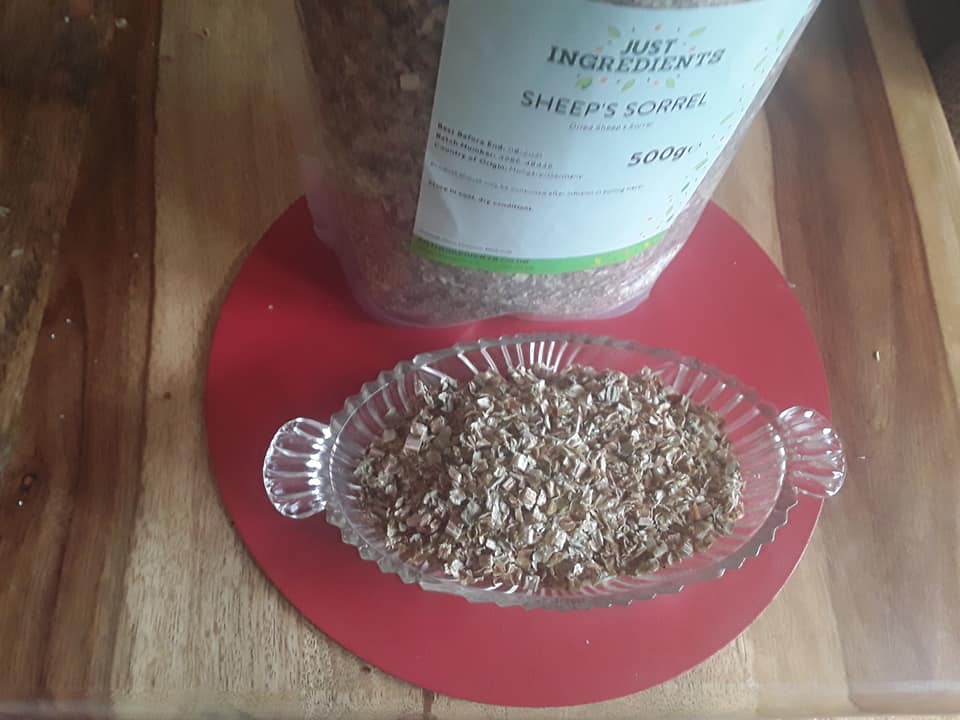
Sheep’s Sorrel. Rumex acetosella syn. Acetosella vulgaris. Plant Family: Polygonaceae. Other Names: Common Sheep Sorrel, Sheep Sorrell, Red Sorrel, Sour Weed, Field Sorrel, Meadow Sorrel, Red Top Sorrel, Sour Grass.
Sheep’s sorrel is an herbaceous perennial plant native to most of the temperate regions of the world. It reaches a height of 30-45cm and has slender upright stems that are tinged red. The leaves are approximately 3-5cm in length, basal, alternate and arrow-shaped, and bright ‘spring’ green in colour. The flowers display in upright panicles of many 6-sepaled reddish inflorescences approximately 2mm in diameter, clustered on slender stalks that branch off the main stem.Brief History: The genus name ‘rumex’ derives from the Latin word ‘rumo’ which means ‘to suck’ and is said to refer to a use the romans put sheeps sorrel to, the sucked the leaves to extract the juice to quench their thirst. Sheep’s sorrel featured on the daily menus of the Romans in the 4th century, when it was used as a green vegetable, which is also said to have been a favourite vegetable of Henry VIII. The tart ‘acidic’ juice from the plant was used to curdle milk. Culpeper says of sheep’s sorrel ‘They are of great use against scurvy if eaten as a spring salad; and the juice is frequently taken among other antiscorbutic juices.’
The leaves can be used to thicken soups and stews and as a vegetarian curdling agent when making cheese. Juice from the plant can be used to remove rust from metal and mould stains on fabrics such as linen. A dark green to brown dye can be obtained from the roots, which doesn’t require any mordant.
Tannin and rumicin, the main components of sheep sorrel, are highly therapeutic. It is a member of the buckwheat family, and is quite common in the northern hemisphere. It is a perennial herb that sprouts from a spreading rhizome. As the plant exhibits
- antibiotic
- anti-inflammatory
- antioxidant
- and diuretic properties
it offers several health benefits. Sheep sorrel root powder is also used to prepare a herbal tea. The herb has a long history of medicinal use, but it remained relatively unknown until dietary supplements containing it were introduced by Essiac Products Inc.
Sheep sorrel can be used to
- strengthen the immune system and fight cancer. The antioxidants in the herb help cancel the effects of free radicals in the body. Thus, they help boost the immune system.
- The tea prepared from the leaves of the plant helps kill intestinal worms or parasites. Thus, it helps improve the function of the digestive system. The tea contains certain chemicals that are toxic to worms.
- The tea prepared from the leaves and twigs of the plant exhibits mild diuretic properties. It helps increase the urine flow. Thus, it acts as a detoxifying agent and promotes fast expulsion of toxins. This helps improve functioning of various organs and systems in the body.
- The anthraquinones present in the herb enhance muscular activity. They bring about an increase in the fluid that is secreted in intestines. All these activities help the food move smoothly through the digestive tract. Therefore, regular consumption of the weed can help prevent constipation.
- The herb acts as a good astringent, as it promotes tightening or constriction of soft organic tissues in the body. The high tannin content is responsible for this. So, it is used to treat diarrhoea or heavy menstrual bleeding.
- The tea exhibits antibiotic and anti-inflammatory properties. Hence, it is used to treat various conditions, like fevers, scurvy, and inflammatory conditions like sinusitis. Tannins present in the herb help lower sinus pressure and inflammation of the nasal passages and respiratory tract. They have a drying effect, and they help reduce mucus production. Thus, they help relieve annoying sinusitis symptoms. The antibacterial compound ‘rumicin’ present in the leaves helps kill bacteria like Escherichia, Salmonella, and Staphylococcus. Thus, the herb minimizes the chances of infection. As a home remedy, it is used to treat viral infections too. Topical application of the tea, tincture, or poultice helps curb the growth of cysts or tumours, and helps alleviate the symptoms of irritating skin conditions like eczema, rashes, and herpes.
- Certain elements like beta carotene present in the herb help slow down the process of ageing. They also prevent macular degeneration related to ageing.
Excessive consumption of the herb can create a laxative effect. Diarrhoea can lead to loss of nutrients present in the body. Always thoroughly research any new herb you are thinking of using. If you are pregnant or breastfeeding, or using prescribed drugs, have a chat with your healthcare provider first. As it contains oxalic acid, it may not be safe for children. Those diagnosed with rheumatism, kidney stones, arthritis, high acidity, etc., should stay away from this herb.
To brew some sorrel and mint tea, place a teaspoon of sorrel leaves and a teaspoon of dried mint leaves in a tea pot. Cover with boiling water and let it steep for ten minutes. Drink hot or cold. This tea contains vitamins which will combat intestinal worms, kidney stones and hepatitis. Besides that it’s very good, especially if sweetened with one teaspoon of honey to each cup of tea.
